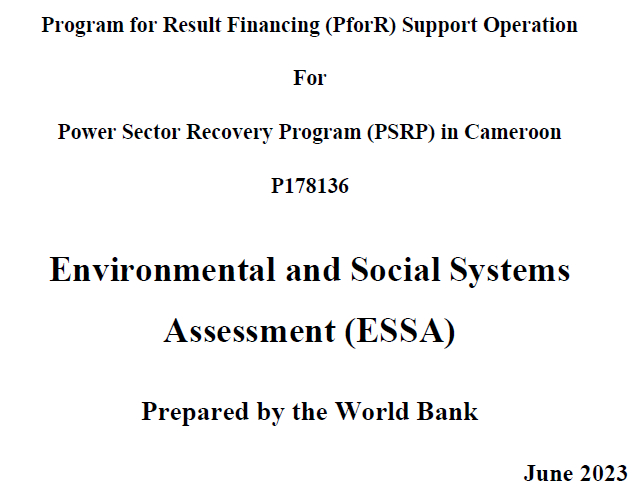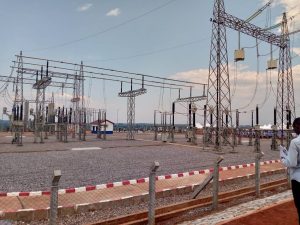Environmental and Social Systems Assessment (ESSA)

Environmental and Social Systems Assessment (ESSA)
TABLE OF CONTENTS
TABLE OF CONTENTS ………………………………………………………………………………………………….. 2
LIST OF TABLES …………………………………………………………………………………………………………… 4
Figure 2.Populations with no Access to Electricity in Cameroon ……………………………………………. 5
LIST OF ACRONYMS …………………………………………………………………………………………………….. 6
EXECUTIVE SUMMARY ……………………………………………………………………………………………….. 9
SECTION I. INTRODUCTION……………………………………………………………………………………….. 26
I.1. Background and Program Description ……………………………………………………………………… 26
I.2 Purpose of the ESSA ………………………………………………………………………………………………. 27
I.3. ESSA Methodology ………………………………………………………………………………………………. 28
I.4. Institutional and Implementation Arrangements ……………………………………………………….. 29
I.5 Environmental and Social Risks of the Program ………………………………………………………… 29
I.6 Key Findings of the assessment ………………………………………………………………………………. 31
I.7. Proposed E&S Program Action Plan ……………………………………………………………………….. 31
I.9 Stakeholder consultations ……………………………………………………………………………………….. 33
ESSA draft report was shared with participant prior to the meeting as per PfoR guidelines.
SECTION II. STRATEGIC CONTEXT ……………………………………………………………………………. 34
II.1 Country’s Energy Context ……………………………………………………………………………………… 34
II.2 Institutional Context ……………………………………………………………………………………………… 35
II.3 Sectorial Context ………………………………………………………………………………………………….. 38
II.4 Poverty, chronic fragility and electricity access and social issues ……………………………….. 39
II.5 Tariffs …………………………………………………………………………………………………………………. 43
SECTION III. PROGRAM DESCRIPTION ……………………………………………………………………… 44
III.1 Previous reforms in the electricity sector. ……………………………………………………………….. 44
III.2 Program Development Objectives (PDOs) and Key Results ……………………………………… 46
SECTION IV. POTENTIAL ENVIRONMENTAL AND SOCIAL EFFECTS OF THE
PROGRAM FOR RESULTS …………………………………………………………………………………………… 53
IV.1 Environmental and social benefits and risks ……………………………………………………………. 53
SECTION V. OVERVIEW OF RELEVANT GOVERNMENT ENVIRONMENTAL AND
SOCIAL MANAGEMENT SYSTEMS …………………………………………………………………………….. 59
V.1 National Legal Framework …………………………………………………………………………………….. 59
V.2 Regulatory and Institutional framework …………………………………………………………………… 60
V.2.4 Environmental Management systems: Policy and Regulatory Framework …………….. 64
V.2.5 Social Management system: Policy and Regulatory Framework …………………………… 67
5.3. Institutional Management System Framework ………………………………………………………….. 69
SECTION VI. SYSTEMS ASSESSMENT AND IDENTIFICATION OF GAPS ………………….. 72
VI.1 Environmental and Social System Assessment ………………………………………………………… 73
Assessment Core Principle 1: General Principle of Environmental and Social Management
…………………………………………………………………………………………………………………………………. 73
Core Principle 2: Natural Habitats and Physical Cultural Resources ………………………….. 75
Core Principle 3: Public and Worker Safety ………………………………………………………………. 75
Core Principle 4: Land Acquisition ……………………………………………………………………………. 77
Core Principle 5: Social Considerations – Indigenous Peoples and Vulnerable Groups … 78
Core Principle 6: Social Conflict ………………………………………………………………………………… 79
SECTION VII. POVERTY AND SOCIAL IMPACT ANALYSIS (PSIA) ……………………………. 81
SECTION VIII. CONCLUSIONS AND RECOMMENDATIONS ………………………………………. 82
VIII.1 Environmental and Social Summary and Recommendations ………………………………….. 82
SECTION IX. PROGRAM ACTION PLAN (PAP) ……………………………………………………………. 85
SECTION X. STAKEHOLDER CONSULTATIONS ………………………………………………………… 91
Download Draft Environmental and Social Systems Assessment (ESSA) – English version


